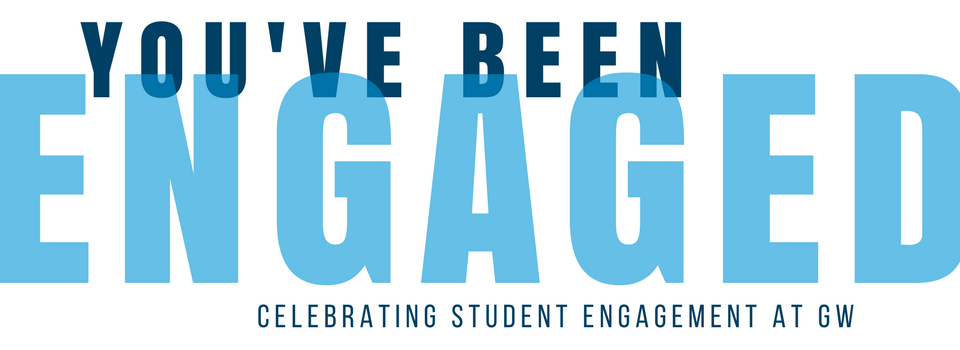by Kaitlyn Schmitt (kschmitt@gwu.edu)
In the field of student affairs, these days it seems most professionals would agree that assessment and data-based decision-making are important. But reporting results to stakeholders? That’s something we’re not so good at as a field. In the Center for Student Engagement (CSE) at George Washington University, we set out to improve how we report assessments results and tell our story - and that’s how the CSE Blog, entitled You’ve Been Engaged, was founded.
About the Blog
The Center for Student Engagement is a large department at GW consisting of 34 full-time staff covering several functional areas: residence life, housing, student involvement, Greek life, leadership education programs, outdoor education, community support for special populations, and more. The CSE Assessment Committee was formed in January 2017 to coordinate assessment efforts across the department and with the Division of Student Affairs. We noticed that while the CSE conducted a lot of assessments and gathered a lot of data, we struggled with closing the assessment loop: ensuring we were making decisions based on the data collected and reporting those results and decisions to stakeholders. To address this, in September 2017 we launched the blog, You’ve Been Engaged.
The purpose of the blog is to tell our story, promote the good work that we do, and share the professional development in which we engage. The posts vary based on topic and author, but we have a few overarching principles and themes:
- Infographics (usually created on Canva or Piktochart) convey information - particularly assessment results - in a visual way, and accompanying text provides additional context and explanation.
- Casual language promotes readability and sustained interest.
- Reflections on professional development experiences encourage staff to critically engage with what they learned, share learning with others, and further justify the funds spent.
- Stories about our big projects are accompanied with pictures to enhance the reader’s experience and understanding.
- Sharing innovative ideas not only promotes our own work, but also allows other institutions to consider adopting new practices in their own work.
Since September 2017, we’ve published 26 blog posts, and we’ve had 1,204 unique pageviews by 559 users, as reported by Google Analytics. The posts cover a variety of topics: from reflections on conferences like NASPA and ACPA to resident advisor selection and student elections. Our most-read post is a poignant account of how one staff member manages her learning disability in her professional work.
Blog Struggles
While the Google Analytics for our blog paint a positive picture, we’ve had some struggles along the way. First, we had trouble generating buy-in, and therefore content, from fellow staff members. The blog was not a priority in their work, so blog posts were often not written in a timely manner. We had a large influx of posts in December when our work slowed down and staff had time to focus on writing - but a blog that only posts twice a year when our work slows is not sustainable. Since then, we’re working on scheduling posts further in advance, so staff will have a deadline and it’s not an artificial one because we’re looking to post on a specific day.
Second, we struggled with marketing and promotion. Our first few posts didn’t get much traction, even among our staff. We started promoting the posts to our staff along with sample tweets or social media posts, so they could share on their own social media with little effort. The most traffic on a post happened when the author promoted the post themselves, especially in relevant communities. For example, one post about first-generation students was shared within the NASPA Center for First-Generation Student Success, and another post about a staff member’s professional involvement helping combat imposter syndrome was shared among the NASPA Pan-African Network. We also started using relevant hashtags to increase our social media reach, such as #SAPros, #ACPA, #studentelections, and more. More than 50% of our traffic comes from social media, especially Facebook and Twitter, which each account for 35% of our referral traffic. Thus, we make it a priority to promote ourselves there.
Future Plans
Looking to the future, we have some plans for additional improvements:
- Posting regularly. During the first year, we published posts as they were written: sporadically. However, blogs are more likely to get return readers with consistent posts, and thus we are now focusing on posting twice a week on Mondays and Thursdays to encourage regular readership. These days were chosen because they are same days our twice-weekly campus newspaper publishes.
- Plan posts intentionally with an editorial content calendar. To help with posting regularly and ensure we are posting the right content at the right times, we aim to use the summer to plan out posts for the year so we can be prepared and on-time. For example, we already have plans to do a spotlight series on the career paths of our staff during Careers in Student Affairs Month in October.
- Share Google Analytics data with staff. To increase buy-in, we need to demonstrate the effectiveness of what we’re already doing. Sharing the analytics has communicated to authors that the CSE Blog is having an impact, which encourages them to write additional articles. Plus, it reinforces the message of the blog; share assessment results with stakeholders.
Our ultimate goal is for an author to get a comment, call, or e-mail from a person at another institution who read their post and wants to learn more. Until that happens, we will continue to promote our work and tell our story!
Kaitlyn Schmitt is a Program Coordinator for Student Involvement, overseeing student organization training and resources. She also chairs the CSE Assessment Committee and manages the CSE Blog.
This post was originally written for the Student Affairs Assessment Leaders (SAAL) blog.

